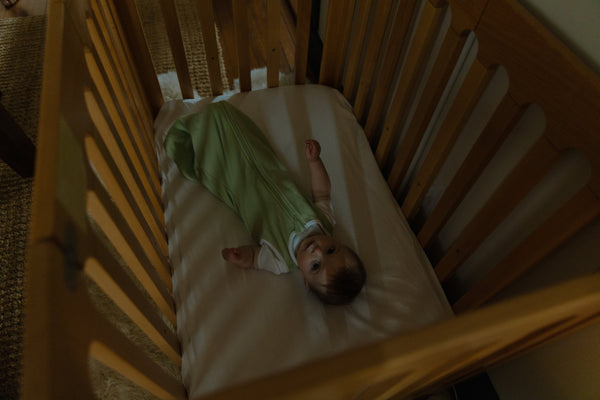How long should your baby nap?
Truth time: How… um, terrifying is the moment you bring your brand-new baby home from the hospital? Sure, it’s a time for bonding and coming into your role as a new parent. But it’s also That Moment When you realize you are solely responsible for the well-being and care of a tiny, vulnerable little human with a lot of needs. No pressure!
While adjusting to this entirely new life is challenging, it may leave you doubting if you’ll ever establish any semblance of a routine again—especially in the sleep department.
You may find yourself wondering, “How long should a baby nap?” New (and new-again) parents worldwide have asked themselves this question time and again, and truthfully, each baby is unique, with several variables in the sleep department. Here are our best tips on baby naps—no matter what age or stage they’re at.
How many naps do babies need?
Whether this is your first parenting rodeo or you’ve collected a few tricks, trophies, and children over the years, one thing is certain: Baby sleep is not a one-size-fits-all affair, and the question “How long should babies nap?” is not a simple one-sentence response.
Let’s dive into the average number of naps babies need each day based on their age:
Naps from birth to 3 months
If there is ever a chapter in life that will humble your appreciation for schedules and routines, it’s the first few weeks after you bring your newborn home. Why? Because one, you’re exhausted from giving birth to a newborn—and two, said newborn really doesn’t care if you’re tired, too (and they need to eat ALL. The. Time)! However, that first week may (ahem) be the most bearable in terms of their sleep “schedule,” e.g. eat/diaper change/sleep/repeat.
But beyond this dazed and confused bubble, your baby may begin waking more frequently and randomly. With no familiarity between day and night, they’ll sleep when they’re tired and wake when they’re hungry. You’ll feel like you’re on call, and maybe a little unsure of whether you brushed your teeth or when your baby last ate (this is where tracking apps are super helpful!). That said, there’s no set number of naps for newborns—and that’s OK.
Instead, you can use this time to set yourselves up for success by helping them adjust to daytime and nighttime with these tips:
- Daytime sleep. Should babies nap in the dark, even if it’s daytime? When your little one naps during the day, it's beneficial to create a dark, peaceful environment for their sleep. You can continue with your day in other areas, ensuring they get the rest they need while keeping an eye on them with a baby monitor.
- Nighttime sleep. When your baby is awake at night, ensure they’re in a quiet space or use a white noise machine to help soothe them to sleep. In addition, during feeding and diaper changes, try to keep the lighting low and avoid excessive interactions, such as talking or playing with them. This can help your baby understand that nighttime is for sleeping, while daytime is for playing and engaging in activities.
Naps from 4 to 6 months
By the time babies are about four months old, many of them have learned the difference between day and night. The next step is working on establishing a nap routine. At this age, three to four daily naps are ideal, depending on the duration of each nap.
Naps from 7 to 11 months
Your baby is becoming busier with each passing day. From crawling to babbling, you’re crossing milestones off left and right. However, all that learning doesn’t stop your little one from needing naps throughout the day. Sometime between seven and 11 months, they'll start needing slightly fewer naps, transitioning to two naps a day.
Naps from 12 to 18 months
One second you have a cuddly, cooing baby in your arms. The next, you are the proud parent of an always-on-the-go and independent one-year-old. While time may be flying, their naps aren’t going anywhere anytime soon. Sometime during this period, most babies will transition to one nap a day.
How long should their naps be?
Now that you’re familiar with the number of naps your baby needs, it’s time to find answers to the question, “How long should babies nap?”
Like the number of naps, the length of each nap depends on your baby’s age. Below, we discuss how long naps should be from day one until year one and beyond.
Naps from birth to 3 months
One of the most common questions for new parents is, “How long should newborn naps be?” In truth, newborn naps can vary enormously. It could be 30 minutes, or it could be two hours. The length of each nap doesn’t matter so much, so long as they are given the opportunity to nap several times each day.
Naps from 4 to 6 months
Around this time, you can begin establishing a nap routine for your little one. Generally, their nap lengths are as follows:
- Total duration: 1.5-4 hours each day
- Per nap: 30 minutes-2 hours
Every baby is unique, and so are their sleep preferences. While your baby might take four one-hour naps between each wake window, your friend’s baby of a similar age might take five naps a day, all of varying lengths—and that’s alright, so long as they appear well rested and happy.
Naps from 7 to 11 months
At this age, most babies follow a nap schedule loosely fashioned around the following durations:
- Total duration: 1.5-3 hours each day
- Per nap: 30 minutes to two hours
Pro tip: If your little one is still sleeping at the two-hour mark, don’t hesitate to gently wake them up. As much as you might enjoy 15 more minutes of “you” time, it’s essential for them to receive enough awake time for feedings and active play. This could prepare them for better naps later in the day and, more importantly, set them up for a night of (hopefully) uninterrupted sleep.
Naps from 12 to 18 months
If your baby turned toddler is still taking two naps, they’ll likely drop one soon in favor of a one-nap day. The duration of each nap will vary from child to child, but typically looks similar to this:
- Total duration: 1-3 hours each day
- Per nap: 1-2 hours
To increase the likelihood of a sleepy baby, try to ensure they’re awake for at least 3.5-5 hours before bedtime. This may also help them sleep more soundly throughout the night.
Tips for perfecting your baby’s nap schedule
While your baby’s cozy crib may have been set up in a day, solidifying a consistent nap schedule will take a little longer. With consistency, you’ll have an effective nap routine established before you know it—and more time to recharge your batteries.
Create a nap routine similar to their night schedule
Consider what the nightly regimen with your little one consists of. For example, if you read them two books, give them a bottle, and then sing a lullaby to them before bed, try following a corresponding mini routine before each nap. Partaking in similar activities is more likely to alert them that it’s time for sleep, no matter where your baby naps during the day.
Here are a few additional tips you can implement to improve your baby’s nap routine:
- Set their room temperature at a cool yet comfortable 68 and 72 degrees F.
- Help your little one stay active between naps by engaging them in age-appropriate playtime activities.
- Learn to gauge your child’s sleepy cues, like rubbing their eyes, pulling at their ears, appearing clumsy, or becoming bored with their toys.
- Don’t stress over a dropped nap. If you’re watching your little one struggle to nap on the baby monitor an hour after you laid them down, it’s alright to end the nap and carry on with your day. Sooner or later, they’ll find their nap rhythm!
Perfect your nap routine with Nanit
Helping your little one find a comfortable napping cadence can make a sizable difference in how they sleep at night. Even when they’re sleeping soundly, you want to know they’re safe and sound.
With Nanit, you’ll always know how they’re doing the moment you lay them down for sleep. Our Pro Camera not only tracks and analyzes your baby’s sleep habits, it also provides sensor-free Breathing Motion Monitoring. Day or night, you can sleep easy knowing Nanit has your baby’s wellness in mind.
Key takeaways
- The number of naps a baby needs varies with their age, with newborns having no set schedule, four to six-month-olds usually needing three naps, seven to 11-month-olds transitioning to two naps, and 12 to 18-month-olds typically transitioning to one nap.
- The length of each nap also depends on age, with newborns napping as long as they want, four to six-month-olds napping for 30 minutes to two hours per nap, seven to 11-month-olds napping for 20 minutes to two hours, and 12 to 18-month-olds napping for 1-3 hours.
- To establish a consistent nap schedule, create a routine, understand and utilize wake windows, maintain a comfortable room temperature, engage in age-appropriate playtime, and learn to recognize your baby's sleepy cues.
Sources:
Stanford Medicine. Newborn Sleep Patterns. https://www.stanfordchildrens.org/en/topic/default?id=newborn-sleep-patterns-90-P02632
Healthy Children. Reversing Day-Night Reversal. https://www.healthychildren.org/English/ages-stages/baby/sleep/Pages/Reversing-Day-Night-Reversal.aspx
Baby Centre. Establishing good sleep habits: 12 to 18 months. https://www.babycentre.co.uk/a7682/establishing-good-sleep-habits-12-to-18-months#
Baby Centre. Baby naps and nap schedules, explained. https://www.babycenter.com/baby/sleep/naps-the-first-year_1506357
Taking Cara Babies. Should You Wake a Sleeping Baby? https://takingcarababies.com/should-you-wake-a-sleeping-baby
Taking Cara Babies. 12 Month Old Sleep Schedule. https://takingcarababies.com/12-month-old-sleep-schedule#12-month-old-naps
The Bump. Wake Windows: How to Time Baby’s Sleep Just Right. https://www.thebump.com/a/wake-windows
What to Expect. Baby Naps and Nap Routine. https://www.whattoexpect.com/first-year/child-sleep.aspx#tips
Raising Children. Tired Signs in Babies and Toddlers. https://raisingchildren.net.au/babies/sleep/understanding-sleep/tired-signs








































